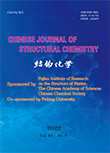Anion-templated Self-assembly for the Preparation of Silver-t-butylthiolate Clusters
JIN Jun-Ling, SHEN Yang-Lin, MI Li-Wei*, XIE Yun-Peng* and LU Xing*
Chin. J. Struct. Chem. 2022, 41, 2203100-2203107 DOI: 10.14102/j.cnki.0254-5861.2011-3357
March 15, 2022
silver cluster, X-ray crystal structure, silver thiolate polymer, self-assembly
ABSTRACT
Silver thiolate polymers are
intercepted to form different structural fragments when reacting with variant
solubilizing reagents, which usually serve as the starting point for the
preparation of clusters. However, such a process is still far from clear.
Herein, we report the controlled synthesis of silver-t-butylthiolate clusters from
reactions of polymeric [AgtBuS]n and suitable templates in
the presence of solubilizing reagents to offer a detailed look at the mechanism
of cluster’s formation. As the provided solubilizing reagents have weak coordination
ability, such as O- or N-donating ligands, the obtained polymeric compound
retains the linear structure pattern that S and Ag atoms are arranged
alternately. When extra templates NO3− and CO32− are applied, the disk-like clusters Ag19 and Ag20 are constructed with the same [AgtBuS]5 circles
that may directly cyclize from the linear [AgtBuS]n fragments. In contrast, (EtO)2PS2− and (iPrO)2PS2− anions have large size and strong coordination ability rendering the structure
of the polymer completely fragmented. Thus extremely short [AgtBuS]n pieces with silver ions and solubilizing ligands
assemble around the templates V2O74− and W2O94−,
leading to the formation of clusters Ag22 and Ag24.








